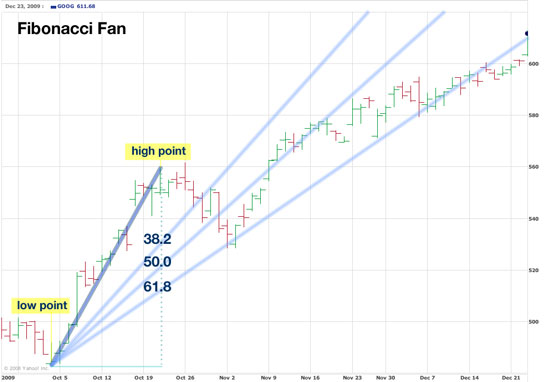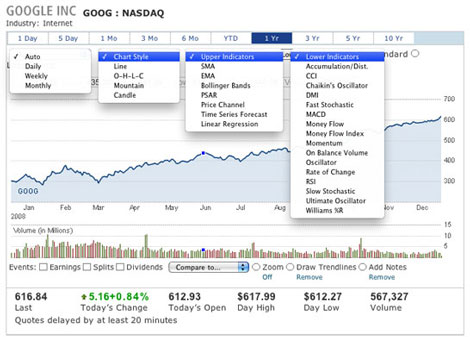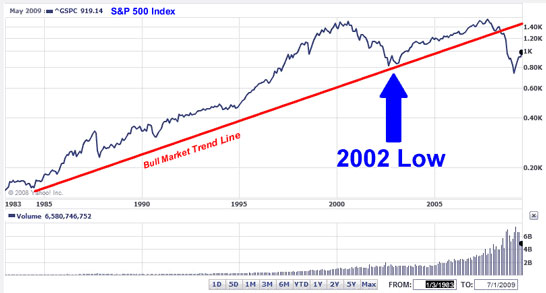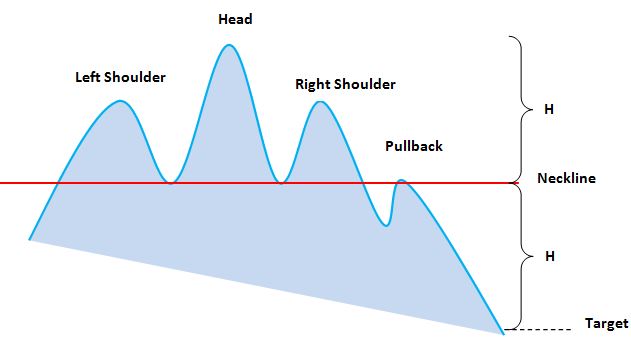[qsm quiz=29]
[qsm quiz=28]
[qsm quiz=27]
[qsm quiz=26]
[qsm quiz=25]
[qsm quiz=24]
[qsm quiz=23]
[qsm quiz=22]
Knowing your net worth is the first step towards growing it! This tool will help you organize your assets in one place, and even help project how they will grow in the future.
If you have used our Home Budget Calculator to help see where you can improve your savings, the next step is measuring your net worth to see how to make it grow.
Once you have found your net worth, you can use our Saving to be a Millionaire Calculator to see what rate of return you need to reach to hit your savings goals!
Pop Quiz
[qsm quiz=68]

Congratulations! You made it through the basic investing course unscathed, armed, and ready to begin a long, successful investment career. You have enough information to begin with some confidence. Remember, you can test your personal investment strategy using the real world simulation. You’ll get all the excitement and results you’d achieve in the market – without risking any of your investment funds.
Remember, you’ve reached the end of this trip, but not THE journey. Keep practicing and constantly improving your personal knowledge base. You will learn which investment types work for you and which do not. Analyze your losses just as diligently as you do your winners.
Enjoy your investment career and the journey as much as the results.
You now have the tools you need to start investing your real money. Start slowly and only invest in something if you fully understand it and don’t hesitate to take the first couple profits that you make. It will build your confidence. Email me at mark@investing101.net and let me know how you are doing or if you have any questions about this course.

Developing a workable investing strategy – and sticking to it through its high and low points – is the major component of your overall action plan. You need to create an investing strategy that is “comfortable” for you. If it doesn’t fit you, you won’t stick to it. Here are some proven ways to select a strategy that works for you:
- Understand who you are and who you are not.
- Understand the true state of your financial fitness. Adopting a strategy popular with the world’s largest investors will do little to help you if your investment fund is less than $5,000. Be honest and create a strategy that makes sense.
- Be brutally honest when evaluating your current economic situation. While staying positive is always a benefit, evaluation of yourself must be just as objective as your analysis of companies and potential investments. At a minimum, consider the following factors
- Your current age
- Your asset position: What assets and available cash do you have?
- Your debt position: How much do you owe?
- Current income and cash flow: How much do you make from all income sources?
- Current expenses: How much do you need to spend monthly?
- Your savings plan: How much can you save regularly?
- Your retirement plans: How much do you think you’ll need to retire comfortably? Use a retirement calculator to give you some guidance
-
Age Average Net Worth Under 25 $9,660 25-29 $37,229 30-34 $136,629 35-39 $298,500 40-44 $491,100 45-49 $690,090 50-54 $702,552 55-59 $1,123,000 60-64 $1,507,000 65-69 $2,294,492 70-74 $2,546,213 75 and over $2,734,001 Evaluate your financial situation as compared to the statistics for average net worth for different age groups.
- Be aware of recommended asset allocations for portfolios of different age ranges to help guide your investment strategy.

Use this and other information you accumulate to construct an investing strategy that fits your finances, personality, and economic goals. You will make better decisions, enjoy your investment activities, and improve your chances of reaching your financial goals.


Like all good athletes, musicians, actors, and astronauts, the word “practice” is central to performance success. The newer investor should adopt this action plan. Just as few people are born knowing how to hit a baseball or play the piano, successful investors are made, not born.
Your investment education should not stop with this course. Continue your education process and learn from your mistakes as you proceed.
You should have already have started trading in your practice portfolio – if you haven’t, its not too late to start!

Even if you start out as a “buy and hold” investor, staying informed at all times is a critical component to your investment career. Should you be tempted to walk the ever-exciting and dangerous tightrope of day trading, your stream of current information is even more important.
Here are some suggestions that will keep you informed, knowledgeable, and ready to make excellent investment decisions. Your portfolio – and your bank account – will thank you.
Investment Newsletters
You will have many choices of investment newsletters. Don’t be afraid to sign up for the free ones (from legitimate companies), and don’t hesitate to unsubscribe if you get too many or you don’t like their approach. There are so many free and valuable newsletters out there, but here are some of the ones we like:
- Fool.com
- TheStreet.com
- CNBC.com
- MSN.com
- SeekingAlpha.com
- PeterNavarro.com (Harvard PhD, Economics Professor)
- Schaeffer.com (for option traders)
- PhilStockWorld.com (for option traders)
Some you will love, while others might bore or confuse you. As a newer investor, you should sample these newsletters and find the ones you like and enjoy. Cancel those that make you crazy or offer no value.
Stick with the basics for now. As your knowledge increases and you become more comfortable with the terms and tips you’ve learned in this course, you may want to upgrade the level of information from those newsletters and I am sure you will find others that you like.
Money Management Techniques
You’ve learned some wonderful money management techniques through this course. However, there are other, more sophisticated techniques and new ideas that are published on a regular basis. Surf the web to stay up-to-date and/or learn about new, cutting-edge money management techniques that might help you make even better decisions.
Don’t worry, money management ideas need not be complicated. Most depend more on common sense than mathematics or strange-looking formulae. Stay informed with money management strategies that work for YOU.

- Over-diversification. Sure, every expert with a pencil, computer, or microphone keeps telling you to diversify your portfolio. They are right, but they often neglect to tell you the rest. For example, assume you only have $200 to invest. You buy 40 different stocks at $5 each. Guess what? Now you’re too “thin” and you have racked up enormous trading fees that start your portfolio at a substantial loss. Even if one or two stocks skyrocket, they won’t make a real difference in your portfolio since they hold a relatively small position in your overall portfolio. 15 to 20 diversified stocks should be plenty and you can have as few as 10 if you are well diversified.
- Becoming a “Trader.” Compile a list of the best investors in the world and you probably won’t find even one who engages in frequent day trading. Smart investing does not equal constant intra-day trading. Even if you have early success as a day trader, the odds, the tax code and the markets are all stacked against you. Like a casino “winner” at Las Vegas, the markets know that the longer you play the day trading game, the better chance you have of losing and giving back all your winnings, and then some. A “buy and hold” investor like Warren Buffet would gladly tell you that you’re crazy to adopt a trader’s strategy.
- Disregarding “time horizons.” Here is a simple example from the banking world. You have $1,200 to invest. You decide that, for an extra quarter percent interest, you’ll put it all in a 5-year CD. However, you need $400 in 6 months. You need to withdraw that amount and forfeit all interest earned. In one year, interest rates spike upward and your remaining 5-year CD is earning well below market rates. You’ve disregarded the investment timeline and it’s cost you money. If you are buying a car soon, or a house in a few years, or you have children that you need to send to college, you need to have a plan to make sure you have the cash available when you need it.
- Making investment decisions based on emotions. Your former superstar stock dropped 10 percent today and you’re in a panic. Relax and do nothing while in this state of mind. Place your laptop where it belongs: In your lap. Investigate the reasons for the decline. You might find that, instead of dumping this stock, you might want to buy more. A funny thing about Wall St. is that it’s the only place on Earth that when there’s a “sale” on the product, people run away.
- Paying too much for investment advice. Many investors, particularly newer ones, overpay for investment services. Feeling that you need full-service brokers is understandable, but the service is usually unnecessary. First, all fees are negotiable. Second, if you’re doing your homework, you can make your own investment decisions. Third, if you’re always dependent on the investment advice of someone else, you’re never truly free and in control of your life. Learn how to invest for yourself and you’ll never have to depend upon costly investment advice!
- Impatience that leads to paying too much for your investments. Do you know the “key” to successful retailing (think shoes, computers, toys, clothing, etc.)? Listen closely: It’s not how much you sell it for, rather it is what it costs you that affects profitability. You can’t predict the future to see when and how much you will sell something for, but you can certainly control the cost. The same is true for investing. The selling price is much harder to predict than the purchase price. Only pay a fair price for your investments. Don’t “chase” a stock price higher and let greed get a hold of you. Remember: new investment opportunities always come around if your current one has escaped you by rising out of your price range.
- Assuming that the future looks like the past. This is a common mistake made by many newer and casual investors. They assume that current earnings will continue and project future earnings at the same or higher level. For example, a consistently mediocre company has a wonderful year. Investors automatically assume the company has found the “secret” to profitability. Once again, adopt a critical, independent viewpoint. Assume nothing. Do the research and learn if they’ve found the “secret” or if they were just lucky in one year.
- Unrealistic expectations. Avoid setting unrealistic or impossible expectations for any investment. It clouds your judgment, generates bad buy/sell decisions, and erodes your confidence. Be realistic with your performance projections and see the long road of a lifetime of investing decisions.
- Suffering paralysis by analysis. You understand that you should be an independent investor, do your own research, and make smart, personal evaluations. However, many newer investors spend too much time exercising their newfound skills. In fact, they love the research and debate so much that they forget to actually do it and get in the game. A fast moving market can make analysis paralysis a costly mistake. Your aim can be perfect, but if you can’t pull the trigger, you’ll never hit your target.
- Lack of a plan or a strategy. Becoming an investor will seldom be a successful experience if you don’t have a working plan and some type of strategy. You may as well just buy lottery tickets or visit your favorite casino (at least you might enjoy a wonderful dinner). The level of sophistication of your plan and strategy is not important. The fact that you have one is critical. A failure to plan is a plan to fail. Think about the many different investment strategies offered in this course and try one risk-free using fantasy money first on your virtual account.

Here are ten important things to remember as you take the next step in your investing journey. These are real world keys that you should embed into your conscious brain to help you become a consistently smart or profitable investor.
- Understand and control the fees and costs of your investing activities. Ask your broker how they charge for stock and option trades. Shop around and try other brokerages. Don’t be shy. You must find a brokerage and platform with which you feel comfortable.In addition to brokerage commissions, be aware of and minimize advisory charges (if you choose to use an investment advisor), mutual fund loads (buying and selling), expense fees for ETFs, the tax consequences (always keep your tax adviser in the loop) of your investing, and closely monitor the overall rate of inflation, which can eat into or destroy your apparent profits.
- Diversify, diversify, and then diversify. Have you heard that before? Typically, the best way to accomplish this goal is to create a good asset mix. Some people think they have diversified if they have many different stocks in their portfolio, but nothing else. This is not true diversity. The assets are all the same.Make sure in your real portfolio that you have a mix of bonds (corporate and U.S. Treasury), commodities like gold and silver bullion, and international stocks/bonds as well. Also, consider the important time component. Along with the obvious (timing a bond’s maturity date correctly), you should consider assets that project to appreciate at different times and plan accordingly.
- Understand your risk. No, really understand your total risk. You may have a clear picture of the relative risk associated with each investment you purchase. However, have you considered the related risks between investments? For example, what is the source of your cash flow with which you live? Are you an employee or a self-employed businessperson? Have you considered what may happen if your cash flow were to stop? Would you be forced to sell your investments before you wanted to?This risk to your portfolio has just greatly increased if you never considered it before. This risk may one day force you to lose money by selling at the wrong time. Many investors have been forced to sell their investments at market lows because they had no other choice – they needed the cash!
You might also be unable to make other timely purchases during a market low because of your lack of cash flow. This is just one example of the additional risks that you might easily overlook when creating your investment strategy.
- Understand percentages. Don’t look at how much the price of an investment went up or down in dollars and cents or “points” – look at its percentage gained or lost. Like casinos that issue worthless plastic chips in order to more easily separate you from your money, you must understand the value of each asset you are holding and understand how much each price change impacts your overall portfolio value.The easiest way to understand how investments are changing in value daily, weekly, monthly or yearly is through percentages. Google (GOOG) went up $5 today and your General Electric (GE) stock went up 50 cents – which performed better for you? That’s a 1% return for GOOG but a 3% return for GE! Further, if the Dow Jones Industrial Average went up 500 points today for a 5% gain, why did your GOOG and GE underperform the market? Pay attention to the percentage changes in all of your assets and compare them to common market benchmarks!
- Avoid buying “hot” stocks, rather you should invest in what you know. Surprised? By the time a stock is considered “hot,” you’ll probably pay too much for it. The amount of press and TV time they command often attract many investors on the buy side, which drives the price up to possibly dangerous “bubble” levels. If you like a hot stock or investment, wait a few weeks or a month to revisit the security. By then, it has probably been replaced by a new “hot” stock and may now be priced more attractively.A better method of investing is to buy what you know. Open your eyes and look to see where you and your friends are spending your money—and where you are NOT! Your own personal and professional knowledge of companies and their products is usually more than enough evidence for you to start doing some fundamental research on their stocks. Investors who stick to what they know and ignore what they don’t know have made many fortunes.
- Use Fundamental Analysis to identify what to buy. Fundamental analysis is a first step in researching possible investments: For stocks, what are the company’s PE ratio, product lineup, and management? For CDs and bonds, where is the overall economy in the business cycle; what are bank CDs and bonds yielding? For commodities, what is in demand now and what will be in high demand in the future for assets like Oil, Gold, and Wheat? This will tell you what is currently undervalued, what is overvalued and what the future is likely to bring for these investments.
- Use Technical Analysis to help you decide when to buy. While Fundamental analysis can tell you what to buy, Technical analysis tells you when to buy. After all, what’s the point in making an investment and having to wait 20 years before you make money and your fundamental analysis is proven correct?That’s why technical analysis indicators like price action and volume play key roles in your life as an investor. Common chart patterns and trend lines will easily guide you in knowing when to buy and when to sell investments that your fundamental research has told you are solid places to invest your money. Technical analysis works not because it is a secret, but because every good investor knows about it, uses it and follows it.
- Set reasonable goals and know that if you outperform the market by 5% then you are doing great! Understand that it is really difficult to beat the market as measured by a benchmark like the S&P 500. Like a fruitless attempt at achieving perfection, constant striving to “double your money in a year” will bring you disappointment. Instead, create a strategy and portfolio that suits the amount of money you have to invest, protects you against downside surprises, projects returns higher than inflation, and “gives you comfort.” Create a realistic investing goal that is achievable. Remember that over 90% of professional mutual fund managers fail to beat the S&P 500 stock market index. You shouldn’t expect to beat it either, at least not right out of the gate.
- Be objective, not emotional. FEAR and GREED are your enemies. These two emotions can be seen in every market, every day. They drive markets up and down and make them gyrate without seeming to make sense. That’s fear and greed at work.When you start to become emotional about your investments, your previously successful portfolio can be turned into a train wreck. Understand that objective investing is always the smartest strategy component. Have solid reasons and goals for making every investment decision and ask yourself: is greed or fear is playing a role? And stick to your plan!
- Be an independent thinker. This is easier said than done and sometimes can take a lifetime of experience before you achieve it. However, if you interviewed the top ten investors on the planet, all would stress that you must invest independently. This doesn’t mean you should totally disregard all suggestions from your broker, other experts, friends, or family. It does suggest that you view all such recommendations with a careful, critical eye.Do your own research, investigation, and evaluation – remember, it’s your money. Treat recommendations, regardless how strong they seem, as just another information source – not a fierce call to action. One way to become an independent thinker is by reading many different opinions and then coming up with your own opinion based upon the facts that you can see.

Summary
Options are exciting investment “vehicles,” but to be used profitably, you need to understand what they mean and what they can or cannot do for you. You have now scratched the surface of the option world.
You’ve now reached a level that gives you some ammunition and skills to play the basic options game. You have some valuable tools that give you the chance to win, too.
Glossary
- The Black-Scholes Model:
- The most generally accepted option pricing model.
- Call Option:
- The right, but not the obligation, to buy a stock at a certain price before the expiration date.
- Covered Call:
- Writing/selling a call option on a stock that you currently own.
- Expiration Date:
- The date that the option expires, usually the 3rd Friday of the month in the U.S.
- Naked Call:
- Writing/selling a call option on a stock that you do NOT currently own.
- Put Option:
- The right, but not the obligation, to sell a stock at a certain price before the expiration date.
- Strike Price:
- The price at which the option contract can be executed.
- Time Decay:
- The reduction in an option price that occurs over time due to the reduced chance of a big price movement in the underlying stock.
Further Reading
- An Introduction to Trading Options
- How to Read an Options Table?
- How do you Find an Option Ticker Symbol?
- What is a Call Option?
- Implied Volatility
- At-the-Money
- Covered Call Writing Strategy
In your virtual trading account:
- buy a call option on a stock that you think is going to go up
- buy a put option on a stock that you think is gong to go down
- write an out-of-the-money covered call on a stock that you have in your portfolio and see if it expires worthless
- buy a put on a stock that you have a profit on and try to lock in those profits
Options are an important instrument for many traders, and to understand options you need to understand options tables and learn how to read option tables!
Depending on the software or website you use, the actual information may vary, but all tables have these basic sets of information:
| Calls | Puts | Strike | Vol | Expiry | Last | Chg | Bid | Ask | Open Int | Symbol |
Calls: This will show whether the option being looked at it is a call (gives the option to buy at a future date)
Puts: This will show whether the option being looked at is a put (gives the option to sell at a future date)
Strike: The strike price is the price at which we can exercise the option. For example, a call option with a strike price of 50 will allow to buy the stock at $50 instead of the current price.
Vol: The Volume works the same as stocks. It is the amount of option contracts that have been traded (Note: options contracts are always for the 100 options! So when you buy 1 option contract you are actually buying 100 options to call or put the underlying stock!)
Expiry: This is the month, day, and year that the option expires. At option expiry you will either get the your profit if you are “in the money” or your options will be worthless if you are “out of the money”.
Last: The last traded price, just like with stocks.
Chg: The change in price from the open to the last price, just like with stocks.
Bid: The price you get when you buy an option.
Ask: The price you get when you sell an option.
Open Int: This indicates the open interest or number of outstanding options contracts.
Symbol: There are many different ways that option symbols are shown, but the symbol is based on the underlying stock, the strike price, and the expiration date. Here is one of the more used symbols:
GE150821C00018000
To understand what this symbol is telling us, we need to break it into parts:
GE150821C00018000
These are what each part means:
GE: This is the symbol of the underlying stock
150821: This is the expiration date: “15” as the year, “08” as the month, and “21” as the day. Now we know this option expires on August 21, 2015
C: This tells us whether this is a “Call” or “Put” option. C stands for Call, P for Put
00018000: The last part is the Strike Price. The rightmost 3 digest are the decimal values (all options go down to tenths of cents, so there are 3 decimal places shown), so we know that this option’s strike price is $18.
Put it all together, and we know this is the symbol for a GE Call stock that expires on August 21, 2015, with a strike price of $18. Similarly, MFST170123P00008275: Would be a Microsoft 2017 January 23rd expiry Put with a strike price of 8.275$.

Put and call interest does not involve the banking definition of interest, but the market excitement – or lack thereof – regarding puts or calls for a security. Before you start thinking we’ve all lost our analytical minds, try to understand that market prices for stocks and put/ call options The right, but not the obligation, to buy a stock at a certain price before the expiration date. are not totally based on sophisticated mathematical formulae and superior financial modeling software.
Just as the market adopts a Bull or Bear mentality for either good or undefined reasons, it reacts similarly to put and call options for different securities. Even if you spend hours at your laptop computer analyzing all available scientific data, the “mood” of the market must still be factored into your investment decisions, including buying or selling options.
For example, you’re considering call options on a few securities. You learn that much of the market is not in favor of these options on these stocks. On one hand, this may mean you can make beneficial deals on these options, as the “option price” will be lower than you thought. However, you also need to consider the reasons for this lack of popularity.
Might it affect the strength of your future purchase price on the negative side? Or, are you simply making a wise option purchase that might mean higher profits for you? Are there many more put than call options? Does the market, as a whole, believe the stock price will decline? Are their conclusions legitimate? Are they wrong, based on your analysis?
Interest, in this sense, is important for you to consider. It should not “dictate” your decision to execute a put or call option. However, you should consider the interest level in both put and call options as an indicator, along with your other evaluations, of what a stock might do, which is either increase or decrease.
The Put verses call interest can also be used to measure market sentiment overall. When more investors are buying calls than puts, sentiment about stocks is generally bullish and they believe stocks will rise in the future. When more investors are buying puts, this indicates a bearish sentiment that stocks will fall. The historical average for investors to buy Puts verses Calls is, not surprisingly, about equal, for a 1 to 1 ratio.

 Any discussion of options and option prices would be incomplete without a mention of the Black-Scholes The most generally accepted option pricing model. option pricing model.
Any discussion of options and option prices would be incomplete without a mention of the Black-Scholes The most generally accepted option pricing model. option pricing model.
Academics Fischer Black and Myron Scholes, in a paper they authored in 1973, stated their theory that an option was implicit to the pricing of any traded security.
Referencing the work of some of the most famous economists, like Paul Samuelson, Black and Scholes developed not one, but three “positions” for your consideration.
- The Black-Scholes Model: A mathematical calculation regarding equities (stocks).
- The Black-Scholes PDE (Partial Differential Equation): This tracks a certain stock’s motion or movement.
- The Black-Scholes Formula: This attempts to compute the prices for put and call options The right, but not the obligation, to buy a stock at a certain price before the expiration date. .
Unless you are a dedicated and hopeless mathematician, you need only know how the work of Black-Scholes might affect your investment activities. While many experts state the limitations of this theory, you might adopt the predictions and projections offered by Black-Scholes calculations to help your options activity.
The Black Scholes formula is used for obtaining the price of European put and call options. It is obtained by solving the Black–Scholes PDE – see derivation below.
Using this formula, the value of a call option in terms of the Black–Scholes parameters is:
The price of a put options The right, but not the obligation, to sell a stock at a certain price before the expiration date. is:
![]()
For both, as above:
- N(•) is the cumulative distribution function of the standard normal distribution
- T – t is the time to maturity
- S is the spot price of the underlying asset
- K is the strike price The price at which the option contract can be executed.
- r is the risk free rate (annual rate, expressed in terms of continuous compounding)
- σ is the volatility in the log-returns of the underlying
All you need to know is that many option trading websites will now show you the Black-Scholes pricing calculation so you can gain a sense of the reasonableness of the option price.

Often used in relation to options, implied volatility is a calculation that compares the current market price of a stock with the theoretical value of the market price in the future, all to predict the true value of an option. This may sound like a risky probability equation – and it is – yet it’s based on sound factual history and intelligent projections for the near future.
Once again, volatility is basically a “neutral” measurement, not an indication of a “good” or “bad” condition or decision. As a measurement (or, in this case, predictor) of “movement,” you must remember that movement may occur in either (up or down) direction. As an investor, you must consider the volatility of different securities when making decisions, particularly with options, either calls or puts.
Implied volatility can affect buyers and sellers of both types of options (put or call), therefore affecting the price you pay or receive for the purchase or sale of options. High implied volatility might cost you more on the buy or sell side, as the other party will incur more uncertainty and risk, projected or real. However, as long as you are aware of this factor, you can price your decisions accordingly, and count on the buyer/seller of the asset to do the same.
Implied volatility plays a large part in the pricing models used to sell options and until recently, the pricing of options was a largely haphazard affair of traders who came up with prices on their own…until the Black-Scholes The most generally accepted option pricing model. model was developed, which we’ll look at next…

 Volatility is a concept that involves all stocks and other securities. For good reasons, high volatility is most often viewed as a negative in the investment world since rapid movements in market prices inherently involve both wins and losses. In investment language, volatility implies two scary conditions for you: uncertainty and risk.
Volatility is a concept that involves all stocks and other securities. For good reasons, high volatility is most often viewed as a negative in the investment world since rapid movements in market prices inherently involve both wins and losses. In investment language, volatility implies two scary conditions for you: uncertainty and risk.
For example, if you are smart (lucky) enough to buy at a stock’s “bottom,” positive volatility (a rapid price rise) could generate wonderful profits for you. Negative volatility, on the other hand, could make you less than pleased as the price of a stock swiftly falls.
Avoid a common misunderstanding that volatility also equals a trend up or down. It does not. Volatility is neither good nor bad, nor does it automatically indicate a trend. It simply measures the speed of price movement.
Everyone likes volatility to the upside (when the market rises quickly), but rarely to the downside (when the market is crashing).
As you’ll see, volatility is a key component in pricing options since the option writer has a great deal of interest in the likelihood of a large price swing (up or down) in the underlying security.
The general indicator for volatility in the stock market is called the VIX index and it measures the premium that options writers assign to stock market volatility. The VIX index is often called the “fear index” because the VIX will rise when the stock market is falling which simply reflects the higher premium option writers are demanding when they write put options The right, but not the obligation, to sell a stock at a certain price before the expiration date. as investors scramble to buy insurance policies (put options) for their stocks.
Historically, the VIX has been in a range between 10 and 20, but during the rocky stock market swoon in late 2008 and 2009, the VIX was more frequently in the 20- 30 range and even hit a high of 90 in October 2008 when investors feared the world was ending and the financial system was said to be at the brink of collapse.
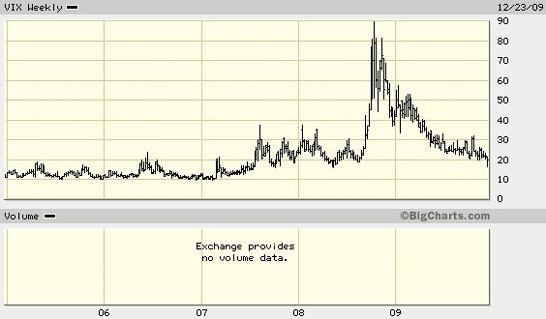
The important thing to remember about the VIX is, when it is high, options become expensive to buy as the implied volatility in the options price rises. We’ll look at implied volatility next…

 We noted earlier that 35% of option buyers lose money and that 65% of option sellers make money. Option trading comes down to the turtle and the hare story. Option buyers are the rabbits that are generally looking for a quick move in stock prices, and the option sellers/writers are the turtles that are looking to make a few dollars each day.
We noted earlier that 35% of option buyers lose money and that 65% of option sellers make money. Option trading comes down to the turtle and the hare story. Option buyers are the rabbits that are generally looking for a quick move in stock prices, and the option sellers/writers are the turtles that are looking to make a few dollars each day.
In the YHOO examples above we said that if YHOO is at $27 a share and the October $30 call is at $0.25, then not many option traders expect YHOO to climb above $30 a share between now and the 3rd Friday in October. If today was October 1st and you owned 100 shares of YHOO, would you like to receive $25 to give someone the right to call the stock away from you at $30? Maybe, maybe not.
But if that October $30 call was currently trading at $2 and you could get $200 for giving someone the right to call you stock away at $30, wouldn’t you take that? Isn’t it very unlikely that with only a few weeks left to expiration that YHOO would climb $3 and your YHOO stocks would be called away? In effect, you would be selling your shares for $32 (the $30 strike price The price at which the option contract can be executed. plus the $2 option price).
Option sellers write covered calls Writing/selling a call option on a stock that you currently own. as a way to add income to their trading accounts by receiving these little premiums each month, hoping that the stock doesn’t move higher than the strike price before expiration. If the October calls expire worthless on the 3rd Friday in October, then they immediately turn around and sell/write the November calls.
When you own the underlying stock and write the call, it is called writing a “covered” call. This is considered a relatively safe trading strategy. If you do not own the underlying stock, then it is called writing a “naked” call. This is considered a very risky strategy, so don’t try this at home!
The reason that option sellers/writers usually win on their trades is they have one very important factor on their side that the option buyer has working against them—TIME. If today is October 1st and YHOO is at $27 and we write the YHOO $30 call to receive $2.00, we have 21 days to hope that YHOO stays below $30. Each day that goes by and YHOO stays below $30, it becomes less and less likely that YHOO will pop over $30. so the option price starts decreasing. On October 10th, if YHOO is still at $27 then the October $30 call would probably be trading at $1.10 or so. This is called the “time decay The reduction in an option price that occurs over time due to the reduced chance of a big price movement in the underlying stock.” of options in that each day that goes by the odds of a price movement become less and less. This is the turtle winning the race!

Now that you have a high level understanding of what options are, let’s look at option trading in a little more detail. When you get a quote on a stock you can also call up its option chain:

First of all, you must realize that not all stocks have options. Only the most popular stocks have options.
Second, you cannot always buy the strike price The price at which the option contract can be executed. that you want for an option. Strike prices are generally in intervals of $5. So if YHOO is trading in the $30 range, it might have strike prices of $20, $25, $30, $35, and $40. Occasionally, you will find $22.5 and $27.5 available for the more popular stocks.
Third, you will not always find the expiration month you are looking for in an option. Usually you see the expiration months for the closest two months, and then every 3 months thereafter.
Fourth, even if you do find the option you are looking for, you need to make sure it has enough volume trading on it to provide liquidity so that you can sell it in the open market, if you decide to. Most options are thinly traded and therefore have a high bid/ask spreads.
Finally, you need to understand where option prices are coming from. If YHOO is trading at $27 a share and you are looking at the October $30 call option, the price is determined just like a stock—totally on a supply and demand basis in an open market. If the price of that option is $0.25, then not many people are expecting YHOO to rise above $30; and if the price of that option is $2.00, then you know that a lot of people are expecting that option to rise above $30.
As you might expect, option prices are a function of the price of the underlying stock, the strike price, the number of days left to expiration, and the overall volatility of the stock. While the first 3 of these (stock price, strike price, and days to expiration) are easily agreed upon, it is the volatility and the expected volatility of the stock that traders differ in opinion and therefore drives prices.
When buying options, you need to be able to calculate your break-even point to see if you really want to make a trade. If YHOO is at $27 a share and the October $30 call is at $0.25, then YHOO has to go to at least $30.25 for you to breakeven. This is because when YHOO is at $30.25, then you know that the $30 call is “in-the-money” $0.25 so it is worth at least $0.25 (your cost of the option). Likewise, if the October $30 call is $2.00, then YHOO has to climb to at least $32.00 for you to breakeven (when YHOO is at $32, then the $30 call is “in-the-money” $2.00 and it will be worth at least $2.00.)
Now let’s look at a specific example so this starts making sense. Let’s say we have done our analysis on IBM (IBM) and we think IBM will go from $84 to $87 in the next few days. Because we think IBM will go up, we want to buy a call and since option strike prices are in multiples of $5, I could buy the $80 call, the $85 call, or the $90 call. Note from Table 1 below that the IBM April $85 Call has the greatest percentage return.
Scenario 1
Buy 100 Shares of Stock and 1 Contract of Each of the $80, $85, and $90 Calls and IBM Closes at $87.

Notice in Table 1 that we spent $8,400 on the stock position and we spent very little on the options. Now in the Table 2 below, we go ahead and invest the same initial amount in options as in the stock so we spend $8,400 on 100 shares, of IBM and about the same on each of the calls. Naturally, the percentage return is the same as in Table 1 above but since now look at the $14,000 profit on the April $85 Call! Even the profit on the April $80 call is nice at $6,300.
Scenario 2
Invest Equal Amounts of Money in Each Stock and Option and IBM Closes at $87

Now, here’s the risky part of trading options. In Table 1 and Table 2 we showed the results assuming IBM climbed from $84 to $87 a share by the expiration date The date that the option expires, usually the 3rd Friday of the month in the U.S.. Of course, stocks don’t always move the way we think, so Table 3 shows what happens if the stock price just declines a bit to $83 a share. Note that for the $85 Call we lost all of our money, but for the $80 Call we only lost $2,100 and, of course, for the stock we only lost the $100.
Scenario 3
IBM Closes at $83.00

Conclusion
If you are sure that a stock is going to pop up a few dollars before the next option expiration date, it is the most profitable (and the most risky) to buy a call option with a strike price slightly higher than the current stock price. If you want to be a little more conservative, you can also buy the call option with a strike price below the current stock price. When in doubt as to what option to buy, always look at the volume in the real market and go where the volume is (I call this following the “smart money”).
Here is the one of the most important characteristics about option trading that you must know: Stock prices move in 3 directions–not only do stock prices move up and down, but they also can stay the same. If prices are random, then over a short period of time you would expect stocks to move up 33% of the time, move down 33% of the time, and stay roughly the same 33% of time. This is actually proven out by a lot of academic research that shows that buyers of calls or puts are only profitable about 35% of the time. So, if buyers of calls/puts are profitable only 35% of the time, that means that the sellers of calls and puts are profitable 65% of the time. The next topic addresses selling (also known as “writing” calls).

 Whereas a call option gives the holder the right to buy the stock at a certain price, a put option gives the holder the right to sell the stock at a certain price. A trader that buys a put option The right, but not the obligation, to sell a stock at a certain price before the expiration date. believes that the price of a security will fall in the near future. You are buying the right – not the obligation – to sell the security for an agreed upon strike price The price at which the option contract can be executed. in the future.
Whereas a call option gives the holder the right to buy the stock at a certain price, a put option gives the holder the right to sell the stock at a certain price. A trader that buys a put option The right, but not the obligation, to sell a stock at a certain price before the expiration date. believes that the price of a security will fall in the near future. You are buying the right – not the obligation – to sell the security for an agreed upon strike price The price at which the option contract can be executed. in the future.
Let’s look at another example using Yahoo! (YHOO) stock. Suppose you think YHOO’s stock price is too high and you expect a sell off. You buy a YHOO October 25 put option at $1, or $100 per contract. This gives you the right to sell 100 shares of YHOO at $25 at any time prior to its expiration on the 3rd Friday in October. If YHOO shares are at $20 by the expiration date The date that the option expires- usually the 3rd Friday of the month in the U.S. in October, then you can exercise your put option and sell shares for $25 when the market is paying only $20 a share, giving you a $5 per share profit and an overall profit of $400 (100 shares x $5 – $100 cost) for that one option contract.
If the price of Yahoo! Is more than $25 by the expiration date, then your option to sell YHOO shares at $25 expires worthless.
Put options offer protection on the downside to limit your losses without severely restricting your profitability. For example, say you already own 100 shares of Yahoo! Stock and you have enjoyed a nice 50% gain in the last 6 months as the stock has gone from $20 to $30 per share. If you buy a put option at the strike price of $30, then you are effectively locking in your price gains for the duration of the options contract without having to sell any of your YHOO shares. There is a cost for this contract, just like there is a cost to be paid for any real-world insurance contract.
Remember this old saying: “stocks slide faster than they glide” meaning that a stock’s price will generally tend to fall quickly while price rises tend to be gradual over time. For me, this has always made put options more attractive to speculate with since the time to see the price of a stock fall is usually shorter than the time to see it rise the same amount.
As with Call options The right, but not the obligation, to buy a stock at a certain price before the expiration date. , you can be a buyer or seller of put options to create protection or arbitrage positions.
Puts are similar to “short positions” (when you sell “borrowed” securities that you do not yet own outright). Don’t worry if it’s a bit confusing, it takes a while for it all to make sense. The best thing to do is keep reading.
Like all other investment strategies, you might win or lose with options. In both put and call options, you must understand the difference between buyers and sellers. The buyers of put or call options are NOT obligated to buy or sell at the agreed upon price. However, call and put sellers (called options “writers”) ARE obligated to fulfill their agreement, in one way or another. That is a significant component in the option world that we will explore next…
OK, that was just a high level introduction. To keep calls and puts straight in your head, just remember that a call option gives you the right to “call” a stock away from someone (think buy), and a put option allows you to “put” a stock to someone (think sell). In the next topic we will look at some real option pricing, trading and strategies.

 A call optionThe right, but not the obligation, to buy a stock at a certain price before the expiration date. is the option (remember, not an obligation) to buy 100 shares of a stock for an agreed price (the strike price The price at which the option contract can be executed.) by an agreed date in the future ( expiration date The date that the option expires, usually the 3rd Friday of the month in the U.S. ).
A call optionThe right, but not the obligation, to buy a stock at a certain price before the expiration date. is the option (remember, not an obligation) to buy 100 shares of a stock for an agreed price (the strike price The price at which the option contract can be executed.) by an agreed date in the future ( expiration date The date that the option expires, usually the 3rd Friday of the month in the U.S. ).
Here’s how it works: you buy one call option contract which expires in October for 100 shares in Yahoo! (YHOO) stock. For now, let’s assume that this call option was priced at $1.00, or $100 per contract. It now gives you the right, but not the obligation, to buy 100 shares of YHOO at $30 per share anytime between now and the 3rd Friday in October.
In the U.S., most equity and index option contracts expire on the 3rd Friday of the month. Also note that in the U.S. most contracts allow you to exercise your option at any time prior to the expiration date. In contrast, most European options only allow you to exercise the option on the expiration date!
If the price of YHOO rises above $30 by the expiration date in October, to say $35, then your options are “in-the-money” by $5 and you can exercise your option and buy 100 shares of YHOO at $30 and immediately sell them at the market price of $35 for a tidy $5 per share profit. Of course, you don’t have to sell it immediately—if you want to own the 100 YHOO shares, then you don’t have to sell them. Since all option contracts cover 100 shares, your real profit on that one option contract is actually $400 ($5 x 100 shares – $100 cost). Not too shabby, eh?
On the other hand, if the market price of YHOO is $25 in October, then you have no reason to exercise your option and buy 100 shares at $30 share for an immediate $5 loss per share. That’s where your option comes in handy since you do not have the obligation to buy these shares at that price – you simply do nothing, and let the option expire worthless. When this happens, your options are considered “out of the money” and you have lost the $100 that you paid for your call option.
Call options that are set to expire in 1 year or more in the future are called LEAPs and can be a more cost effective way to investing in your favorite stocks.
Always remember that in order for you to buy this YHOO October 30 call option, there has to be someone that is willing to sell you that call option. People buy stocks and call options believing their market price will increase, while sellers believe (just as strongly) that the price will decline. One of you will be right and the other will be wrong. You can be either a buyer or seller of call options.
The seller has received a “premium” in the form of the initial option cost the buyer paid ($1 per share or $100 per contract in our example), earning some compensation for selling you the right to “call” the stock away from him if the stock price closes above the strike price. We will return to this topic in a bit.
Understanding Call Options

 Generally speaking, options are used in many areas of business and investment. Employees of larger companies frequently get stock options as an incentive to stay with the company for a long time and help the company increase in value. A lot of real estate transactions involve the option to purchase additional neighboring acreage at a certain price within a certain number of years. And even leasing a car usually contains a “purchase option” at the end of the lease term.
Generally speaking, options are used in many areas of business and investment. Employees of larger companies frequently get stock options as an incentive to stay with the company for a long time and help the company increase in value. A lot of real estate transactions involve the option to purchase additional neighboring acreage at a certain price within a certain number of years. And even leasing a car usually contains a “purchase option” at the end of the lease term.
So what is an option? In its simplest form, an option is an agreement that gives the holder of an option the right, but not the obligation, to buy (or sell) something at an agreed upon price by an agreed upon time. Sometimes, the holder or buyer of the option pays a fee to the seller in order to have this right.
Here is a simple, common example that should help. You and your spouse locate a perfect home that you’d love to buy. The only problem is the timing, as you won’t be in position to purchase the home for around six months. You and the seller agree to a price to purchase the home in the time period that you want – up to six months for now. For this seller concession, you agree to pay $2,000 (non-refundable if you chose not to buy) to the current homeowner. This contract gives you the option, but not an obligation, to buy that house at the agreed upon price at any time for the next 6 months.
In the investment world, the “house” in our example becomes a stock and is called the “underlying security.” The agreed upon price is called the “ strike priceThe price at which the option contract can be executed. ” and the end date of your agreement is called the “ expiration dateThe date that the option expires, usually the 3rd Friday of the month in the U.S..” The important factors are the agreement, the selling/buying price, the cost of the option, and any conditions to which the parties agree. To review, here is the real world option language verses and the investing option language:
| “Real World” language | Investor language |
|---|---|
| House: | Underlying Security (ie, Stock) |
| Buying price: | Strike price |
| Date agreement ends: | Expiration date or Expiry |
| Actually buying the house: | Exercising the option |
A key difference between this house example and stock options is leverage. Stock options allow investors to buy 100 shares of stock in a single option contract. For the rest of this chapter, remember that a single option contract covers 100 shares. So when we say an option is trading at $1.25, that means that option contract will actually cost $125.
As you will see, options can play a key and often times exciting role in your investment success. Let’s get started…

Summary
This lesson focused on hot topics in the investment world. Obviously, by the nature of discussing “hot” topics, conditions can change quickly, sometimes making hot topics cold and others newly hot. However, the issues in this lesson have been “hot” for some time and should continue to be important for the foreseeable future.
Further, just because an investing theme is “hot” does not mean you should shun it. There are always opportunities to make money in these situations. The first way is by acknowledging and embracing the hot trend. As the saying goes, “the trend is always your friend” and if you are able to “ride the wave” of a hot investing theme, there is lots of money to be made while the speculative bubble is growing larger. However, you MUST know when to get out before the bubble pops and prices plunge!
The other way to play a hot investing trend is to short it: bet that the trend can’t continue forever upward and that prices will soon fall. The danger in this strategy is that, as economist John Maynard Keynes has famously remarked, “markets can stay irrationally strong longer than you can stay liquid.” So, the key is getting your timing right if you want to short a hot investing trend.
The wisest choice, especially for a new investor, is to keep your money far away from anything that seems too popular, too hot or too much of a “can’t miss” investment.
Once again, knowledge is power. The reverse, lack of knowledge, can become problematic in the investment world. Having a basic understanding of the popular topics in this lesson should help you increase your successes and better control your losses. Like a successful sports team, at the end of measurable periods (day, week, month, quarter, and year), you should strive to have more wins than losses. You needn’t strive to be perfect, as you might become discouraged. Try to achieve a good knowledge base and a smart strategy to maximize your winners. Be aware of the “hot” topics and use them to help you achieve your investing goals.
Glossary
Arbitrage:
Taking advantage of price differences in at least two different markets by buying the same security at the cheaper price and immediately selling it at the higher price.
Bulletin Board or OTC Stocks:
Stocks that trade on the NASD with tickers that end in an “.OB”, but have no listing requirements, very small revenues and assets, and prices that are volatile with light volume and large bid/ask spreads.
Day Trading:
The buying and selling investments (stocks, futures, stock options, commodities, currencies, etc.) within the same trading day, so that all positions are closed before the end of each day.
Pink Sheet Stocks:
Stocks that are quoted by the National Quotation Bureau, have tickers that end in “.PK”, are smaller than the OTCBB stocks, and that don’t even have to file financial statements with the SEC.
Swing Trading:
Identifying “channels” or “tunnels” of price movements on a stock’s chart and then buying when the price gets to the bottom of the channel and selling when it gets to the top, usually over a few days.
Further Reading
•Day Trading Stocks
•Pink Sheet Stocks
•Arbitrage Stock Trading
Exercise
Try your hand at one of the investing styles described in this chapter that interests you the most and make several trades in your practice account to get a feel for how the strategy works.

The subject of arbitrage Taking advantage of price differences in at least two different markets by buying the same security at the cheaper price and immediately selling it at the higher price. is a bit confusing for the new investor, but you will undoubtedly hear the term as you start reading more and more about investing. In its simplest form, arbitrage is taking advantage of price differences in at least two different markets. By making simultaneous deals to maximize this difference, you can generate some profit using an arbitrage strategy.
For example, Stock A has a market price of $45 on one exchange, but has a current market price of $50 on another. Buying shares at $45 and immediately selling at $50 in a different market returns a tidy $5 per-share profit. Because of the global economy and the efficiency of electronic communications, this may be more of a textbook than a real-world example, but this is how arbitrage works.
The most common form of arbitrage is with Mergers and Acquisitions (M&A). When one publicly traded company wants to buy another publicly traded company, they usually must pay a premium for their shares. For example, let’s say Company X wants to buy Company Y. Company Y’s shares trade for $20 and Company X proposes to buy them out at $30/share or a 50% premium.
Here’s where the arbitrage stock trader comes in quickly. Seeing that there is a proposed deal for Company Y’s shares at a much higher price, traders start to buy up shares and the price rises. However, there is always a chance the deal will not go through. Effectively, M&A arbitrage is a bet that a proposed merger or acquisition will go through.
Arbitrage operates as both an offensive and a defensive strategy. While you hope it returns excellent profits for you, arbitrage can also function as a “protection” and risk mitigation strategy. Making arbitrage trades can also protect you from a major loss, while giving you the opportunity to enjoy a serious profit in an upside market.
To use a real-world example, you probably have done some arbitraging and just not realized it. Here’s a classic example: at Christmas time you go to an electronics store and buy a game for your kids that costs $99. The next day, at Wal-Mart you see the same game for $89. So what do you do? You buy the $89 game at Wal-Mart and return (sell back) the $99 game to the other store for a savings (you could say an “arbitrage profit”) of $10.

Investor sentiment, sometimes also called market sentiment, typically relates to the stock market’s “attitude” towards specific securities, industries, or overall market conditions (bullish, bearish, or neutral. While of limited importance to a buy-and-hold investor, investor sentiment can be an effective tool if you decide to live in the fast lane by adopting a day or Swing tradingIdentifying “channels” or “tunnels” of price movements on a stock’s chart and then buying when the price gets to the bottom of the channel and selling when it gets to the top, usually over a few days. strategy.
In the short-term, investor sentiment can affect market prices to a large degree. There are even companies, like Chartcraft, that publish “investor sentiment indexes” to indicate the level, positive or negative, of investor and market feelings.
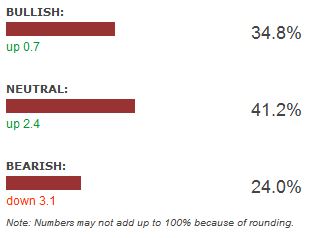 As a newer investor, if you can get a sense of the investment community towards your stocks, you will have good information to make better trades. Even if investor sentiment is bearish (predicting a down market), you can adjust your strategy to make profitable trades in the short-term.
As a newer investor, if you can get a sense of the investment community towards your stocks, you will have good information to make better trades. Even if investor sentiment is bearish (predicting a down market), you can adjust your strategy to make profitable trades in the short-term.
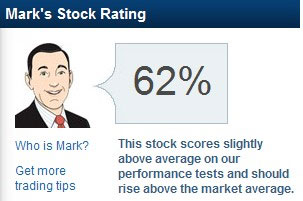

Insider transactions and trading has become a sensitive topic in recent years. Most thoughts tend to be negative (images of Martha Stewart in prison mayspring to mind), giving the impression that all insider transactions are illegal or unethical. Not true.
Technically, insider transactions involve an employee of a company trading his own company’s stock or other securities. However, just because an officer of a company bought or sold his company’s stocks doesn’t mean that he was acting on knowledge that was not available to the investing public. Company employees buy and sell their shares quite frequently as they receive stock options as part of their compensation package, exercise those stock options, and then sell the shares they received from the options.
Obviously, company officers, management, and other employees often, by necessity, have access to internal information that fits a “non-public” definition. However, simply having this information and trading company securities is legal and acceptable. The public, the SEC (Securities and Exchange Commission), and the Attorney General’s office will have no issues with normal trades by “outside insiders.”
The problem (and illegality) with insider transactions arises when corporate employees learn of “material information” (important issues, good or bad) that spurs them to buy or sell their own company’s securities. Should these trades involve executives or officers of the company, they may violate their “fiduciary responsibility” that comes with their powerful positions, which mandates trust, confidence, and honesty.
However, there is a way to profit from the legal trades of insiders. A company’s management is given windows of time each year to make legal purchases or sales of their company’s stock. And these transactions are all public information.
Doesn’t it make sense that company insiders would have the best view as to the future business prospects for its company? That’s the theory behind following the insider transactions of a company’s stock. If an insider makes a big purchase of their company’s stock, it’s usually a very positive sign, while the opposite is equally true.
Many websites offer insider trading information based on the forms that insiders must file with the SEC when they trade. The MSN Money site shows you insider transactions by stock tickers.

Insider transactions for Google (GOOG)
As part of my fundamental analysis of a company, I always like to see the insider trading trends. Some people swear by it, but I’m just a little suspicious. Just because an insider or two is selling shares (maybe one is buying a new house and the other is doing some estate planning) doesn’t mean the stock is not a good value—it just means that someone at the company is buying a nice house.

 During the height of the dot.com explosion, a popular strategy – growth at any price – became the rallying cry for many investors. After the bubble burst, a more conservative strategy known as growth at a reasonable price, or GARP, became and remains a popular investing action plan.
During the height of the dot.com explosion, a popular strategy – growth at any price – became the rallying cry for many investors. After the bubble burst, a more conservative strategy known as growth at a reasonable price, or GARP, became and remains a popular investing action plan.
Paying a high price for a rapidly rising security can result in some serious losses if it cannot sustain its impressive growth. Take a look at the graph of Crocs (CROX) below. This is that plastic, colorful shoe company that became very popular a few years back:
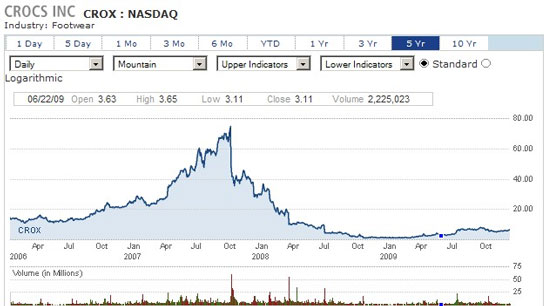
The chart above of Crocs, Inc. (CROX), shows us the risk of buying a high growth company too late.
Crocs is a great example of the risks of investing too late in a fast growing company. However, stocks growing at a more moderate, sustainable rate may be smart purchases because they tend to deliver more profit with less risk of major losses like the high flyers (CROX). Take a look at Google (GOOG) below. It is clearly a growth company and has been for years.

The graph of Google (GOOG)shows us how it has taken a few hits, but has a more sustainable growth rate and business.
Growth investing is similar to “value” investing as most people equate the ability to grow with the intrinsic value of a company and its stock. Growth at a reasonable price suggests you should value securities in relation to similar stocks, stocks that have experienced similar growth, but carry higher market prices.
For example, if you were interested in investing in big technology companies, you could use the GARP method to choose the fastest growing technology companies with the most reasonably priced stocks, relative to their profits and expected future rates of growth. Let’s look at
Microsoft (MSFT), Yahoo! (YHOO), Google (GOOG) and Apple (AAPL) using the GARP method.
| Stock | Price to Earnings (P/E) Ratio | Projected Earnings Growth (PEG) |
|---|---|---|
| MSFT | 19.7 | 18% |
| YHOO | 185.6 | 47% |
| GOOG | 38.5 | 30% |
| AAPL | 33.5 | 50% |
Looking at the relative PE ratios and PEG ratios above, we see that Microsoft has the smallest valuation (a PE of just 19.7). But it also has the smallest projected growth rate (just 18%), which probably explains why it is a relatively cheap stock compared to its peers.
On the other hand, Yahoo! has a crazy, sky-high PE ratio of 185.6 and a very high projected earnings growth rate of 47%. Google and Apple also have high PE ratios, but nothing like Yahoo’s. Their projected earnings are also better than Microsoft’s: 30% and 50% verses just 18%.
So far, we can see that in this comparison, Google and Apple deliver very good growth without an expensive price tag. That eliminates Microsoft and Yahoo! from consideration, but how do we choose between Google and Apple?
Since Apple has better growth prospects (50% vs. 30% growth) and a cheaper valuation to Google’s (33.5 vs. 38.5), it is our clear winner in this GARP analysis. Not surprisingly, Apple was one of the best stocks to own in 2009 as it returned more than 120% to investors who owned it. And looking at a chart of all 4 stocks we considered above, it may be tempting to assume that everyone used the GARP method to pick stocks in 2009:
In 2009, Apple gained more than 125%, Google 80%, Microsoft 50% and Yahoo! just 30%
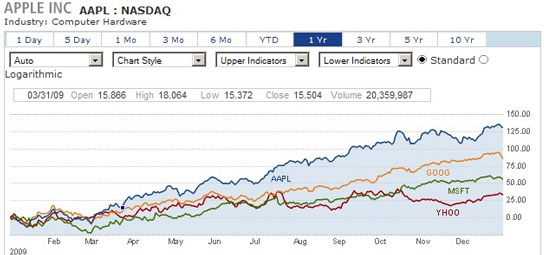
Of course, the quality of a GARP analysis is dependent on the projected future earnings for a stock and these can change at any moment. Still, GARP analysis is helpful in choosing between stocks in the same industry because if earnings projections change for one company, they also usually change for every stock in that industry.
Don’t worry if you’re not right on every occasion; no one is. But, making smart decisions based upon solid research and reasonable expectations should return good profits over time.

 The most popular investment strategy preached by brokers, fund managers and even famous investors like Warren Buffet is “buy and hold.” In its most basic form, this strategy believes that you should only buy stocks of solid, well managed companies that will deliver profits for decades to come; furthermore, that you should hold onto these stocks for decades and not worry about the wild swings that we see in the stock market. If you think this description sounds like the opposite strategy employed by day traders, you’re right.
The most popular investment strategy preached by brokers, fund managers and even famous investors like Warren Buffet is “buy and hold.” In its most basic form, this strategy believes that you should only buy stocks of solid, well managed companies that will deliver profits for decades to come; furthermore, that you should hold onto these stocks for decades and not worry about the wild swings that we see in the stock market. If you think this description sounds like the opposite strategy employed by day traders, you’re right.
Instead of spending your days looking at charts and drawing trend lines and support and resistance lines, spend your time studying the companies that are the biggest and most profitable in the World. What is the best energy company in the U.S.? What is the best consumer products company? What is the best bank in the World? What is Warren Buffet investing in?
When you are just getting started and trying to pick stocks, it is easier to follow the experts and ride the ups and downs as they do. As you can imagine, this strategy removes much of the built-in stress that occurs with day tradingThe buying and selling investments (stocks, futures, stock options, commodities, currencies, etc.) within the same trading day, so that all positions are closed before the end of each day. or swing trading Identifying “channels” or “tunnels” of price movements on a stock’s chart and then buying when the price gets to the bottom of the channel and selling when it gets to the top, usually over a few days.
However, the payouts are smaller and steadier and you will have less to brag about at the cocktail parties.
The acknowledged guru of buy-and-hold strategies is world-renowned investor, Warren Buffet. For decades, Mr. Buffet never bought a stock that he didn’t want to hold for at least 5 years, and he has seldom been a seller. Remember that Buffet once said his holding period is “forever.” Many other investing experts question the “intensity” of his strategy, believing that he is too restrictive by holding almost all of his investments. There is little argument that his extreme buy-and-hold strategy has worked amazingly well for him, as he is one of the wealthiest people on our planet.

Warren Buffet’s holding company, Berkshire Hathaway (BRK.A) is the best example of a buy and hold strategy. It has clearly outperformed the S&P 500 index (green line in chart above, ticker symbol SPY) over the last 10 years. As the S&P 500 index lost about 10%, Berkshire Hathaway (BRK.A) gained about 75% over the last decade.
In spite of the conventional wisdom that buy and hold is the way to invest, many people are starting to question this strategy. Because times are changing so fast, technology is changing so fast, and consumers’ buying behavior is changing so fast, it appears that business cycles are getting shorter and that a successfully managed investment portfolio needs to react to these market conditions.

 Penny stocks are often popular with the newer and smaller investor. These investments are classically defined as any stock that sells for less than $5.00, traded outside the major exchanges, and often traded on the OTCBB (Over-the-Counter Bulletin Board Stocks that trade on the NASD with tickers that end in an “.OB”, but have no listing requirements, very small revenues and assets, and prices that are volatile with light volume and large bid/ask spreads. ) market or on the “Pink Sheets.” In recent years, the names “nano caps,” “micro caps,” and “small caps” have also become popular to identify penny stocks.
Penny stocks are often popular with the newer and smaller investor. These investments are classically defined as any stock that sells for less than $5.00, traded outside the major exchanges, and often traded on the OTCBB (Over-the-Counter Bulletin Board Stocks that trade on the NASD with tickers that end in an “.OB”, but have no listing requirements, very small revenues and assets, and prices that are volatile with light volume and large bid/ask spreads. ) market or on the “Pink Sheets.” In recent years, the names “nano caps,” “micro caps,” and “small caps” have also become popular to identify penny stocks.
OTCBB stocks are offered on the NASD exchange and must file financial statements with the SEC and their stock tickers usually end in an “.OB”. Since there are no listing requirements, the companies are very small in terms of revenues and assets, and the prices are usually very volatile. Volume is usually very light, which therefore creates a large bid/ask spread. The next lowest level of publicly traded stocks is called “Pink Sheets” and is quoted by the National Quotation Bureau. These stock tickers usually end in “.PK”, and their companies are usually even smaller than the OTCBB stocks.
In the U.S., penny stock designations are not decided by the “market cap” (number of shares outstanding times share price), but by market price. In the U.K, however, penny shares do often refer to small cap stocks (companies with less than £100 Million) along with their low price.
Pump and Dump Schemes
The biggest problem with penny stocks is that because of their low price and light trading volumes, penny stocks can be subject to market manipulation by criminals who conduct “pump and dump” schemes. Here’s how the scam works: a company or individual distributes misleading or outright bogus information about a company that it owns stock in. Typically, these pump and dump schemes will publish a bogus press release announcing a “revolutionary product” to be released by a company or will post a false rumor about a company in a popular Internet stock market forum.
Then, when an unsuspecting public (who believe everything they read) starts to buy a few thousand shares, just in case the story is true, the stock shoots to $1.00, and the original owners who distributed the bogus information start selling their shares into the rally. Eventually the pumping and buying recedes, and then the price falls right back to where it was originally, or even lower. The public who bought the shares is sitting with huge losses while the pump and dump scammers have made a killing.
The Securities and Exchange Commission in the U.S. is on the constant lookout for these scams and they are highly illegal, but they still exist.
Penny stocks with compelling stories are tempting to throw money at. After all, wouldn’t YOU like to own 50,000 shares of a 2-cent stock that jumps up to 50 cents when they land that first deal with Microsoft or when they get their drug approved by the FDA? That would turn your $1,000 investment into a quick $25,000 investment! The truth is that a 2-cent stock is priced at 2 cents because it is probably worth close to nothing. But as the saying goes, a sucker is born every minute and those suckers continue to have hope and that drives the stock up. Learn this old Latin phrase: Caveat Emptor = Buyer Beware!
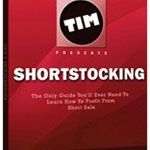 One investor who has literally made millions in busting penny stock “pump and dump” schemes is Timothy Sykes. As a teenager, he turned $10,000 into his first $1,000,000 by spotting and then shorting these pump and dump schemes.
One investor who has literally made millions in busting penny stock “pump and dump” schemes is Timothy Sykes. As a teenager, he turned $10,000 into his first $1,000,000 by spotting and then shorting these pump and dump schemes.

 Swing trading Identifying “channels” or “tunnels” of price movements on a stock’s chart and then buying when the price gets to the bottom of the channel and selling when it gets to the top, usually over a few days. is identifying “channels” or “tunnels” of price movements on a stock’s chart and then buying when the price gets to the bottom of the channel and selling when it gets to the top.
Swing trading Identifying “channels” or “tunnels” of price movements on a stock’s chart and then buying when the price gets to the bottom of the channel and selling when it gets to the top, usually over a few days. is identifying “channels” or “tunnels” of price movements on a stock’s chart and then buying when the price gets to the bottom of the channel and selling when it gets to the top.
Swing trading can be done with any time period: Intra-Day, Daily, Weekly or Monthly -depending on the trader’s temperament and ability to dedicate time to follow the stock’s price.
Done an intra-day basis, swing trading is like day trading The buying and selling investments (stocks, futures, stock options, commodities, currencies, etc.) within the same trading day, so that all positions are closed before the end of each day. on steroids coupled with a safety net. It considers short-term price cycles caused by daily swings in market prices.
Most swing traders, however, are holding stocks for a few days or up to a week. Their idea is that minute-by-minute or hour-by-hour price movements are too random to predict, but when smoothed out over a few days, a better picture emerges of the trends, support and resistance levels:

Apple’s (AAPL) share price bounced inside predictable “channels” that made weekly swing trading very profitable in late 2007.Two clear advantages of swing trading are that it doesn’t suffer as much as day trading in terms of commissions paid, and it is OK to step away from your computer for a few hours if you need to.
Most swing trading strategies consider the possibility of a price move in a short (two-to-four-day) period. Popular with individual traders, swing trading is seldom used by large, institutional traders since they typically cannot react quickly enough to make this strategy work in their favor. Smaller investors and individuals, however, can enjoy some excellent profits if their swing trading strategy is sound. Yet, you must understand, that there is substantial risk like there is with day trading.
I found that the pace is too quick in day trading, and that I couldn’t always place and manage realistic stop loss orders. But with swing trading, since you have a little more time to react and establish a trading plan, you can make better use of limits and stop loss orders to manage your portfolio and reduce risk. Also, with swing trading you can easily manage 5 to 8 simultaneous positions, something you could never do as a day trader.


The buying and selling of investments (stocks, futures, stock options, commodities, currencies, etc.) within the same trading day, so that all positions are closed before the end of each day, is called day trading The buying and selling investments (stocks, futures, stock options, commodities, currencies, etc.) within the same trading day, so that all positions are closed before the end of each day.. Beginning investors should understand that day trading is very difficult to do successfully because you are trading against professional traders that have better access to information, faster computers, and faster trade execution platforms. Sure, you will have a winning day or two, but the majority of beginning investors end up getting crushed.
Day trading became popular during the Dot.com stock market bubble for a variety of reasons. First, the growth of the Internet made more and more data available to the individual investor (this data had previously been available only at brokerage offices). Second, the growth of software and trading strategies on various websites made learning about trading, and especially charting stocks, easier. Third, brokerage firms rushed to encourage active trading as they were forced to lower their commission structures due to competition in the online discount brokerage market (with lower commissions per trade they needed more trades to keep profits up). And finally, in a bull market, just about everyone begins to think that they are an expert stock picker because everything they buy goes up and up!
As it turns out, if those day traders had left their money in their stocks overnight for several months during the boom, most of them would have been better off because they would have paid fewer commissions, paid fewer short-term capital gains taxes, and they would have slept better!
Unlike those who are looking for long-term appreciation and growth of a portfolio, day traders are playing an active game every day the market is open. The securities are subject to short-term spikes – up or down – often based on factors over which investors have no control or even knowledge.
Should you wish to be a day trader, you should become comfortable with making and losing money – real money, not paper profits – on a daily basis. Also, be prepared to pay lots of fees to your stock broker. Even if you use an online discount broker that charges less than $10 per trade, those fees add up and begin to eat into your profits, if you can manage to make any as a day trader.
Level 2 Quotes
One popular strategy of day traders is to look at Level 2 quotes. Whereas Level 1 quotes show you the best bid and ask prices for a stock, Level 2 quotes allow you to see all of the bids and offers and the volumes of each order on the stock. Theoretically, if you see a lot of buy orders and only a few sell orders in the queue, then you would expect the price to hold firm or rise slightly. Or you could see a 10,000 share sell order and only a few 100 share buy orders—indicating a short-term price drop as those 10,000 shares being sold will drive the market down. Trading 500 shares of a stock and catching a 10-cent rise in a few minutes is a quick $50 profit. If you could do that 10 times a day, that’s a $500 per day profit.
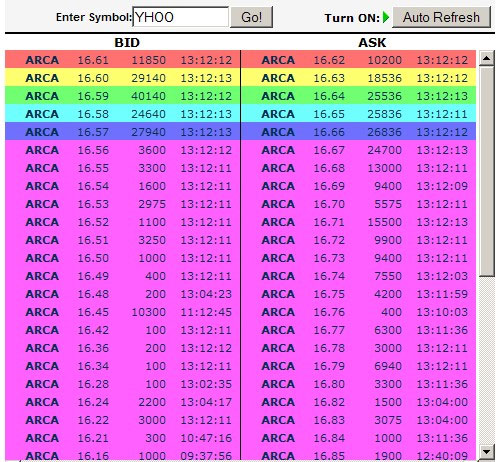
A typical display of Level 2 quotes for a stock showing the queue of Bid orders on the left and Ask orders on the right.
Day trading is not for the timid or the uninformed. Market prices can change very quickly and experience wide swings as the result of heavy trading, breaking news, or market whims. Successful day traders are the subject of legend, books, and movies. However, day trading failures are more numerous than successes because of the heightened risks.
Here’s a funny and true story from the Wall Street Journal shortly after the NASDAQ bubble burst in 2000. A man goes to get the oil changed in his car. After waiting more than 30 minutes for a service that normally takes less than 15, he walked into the garage to ask the auto mechanic what the problem was. As he got closer, he saw the mechanic staring at a computer screen and he thought the mechanic was using it to test his car. Instead, he saw that the mechanic was looking at charts of stocks and was actually day trading instead of changing his oil! At that point, he knew the stock bubble had gone too far and he sold all his stocks when he got back to the office.

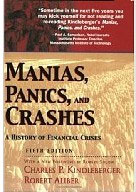 Your first order of business in looking at current investing trends is to see if the hot trend is worthy and justifiable, or whether it is just a mania leading to a bubble. While it can be profitable to ride the bubble as it is getting started, it is extremely important to make the leap out before the bubble bursts. Doing that, of course, is easier said than done.
Your first order of business in looking at current investing trends is to see if the hot trend is worthy and justifiable, or whether it is just a mania leading to a bubble. While it can be profitable to ride the bubble as it is getting started, it is extremely important to make the leap out before the bubble bursts. Doing that, of course, is easier said than done.
By now, you should already know that when you use Stop Loss orders, you will NOT be as susceptible to bubbles as compared to those investors who are NOT using Stop Loss orders.
In his book “Manias, Panics, and Crashes: A History of Financial Crises”, Charles Kindleberger notes that bubbles always implode and are easily recognizable because the bubble represents a “non-sustainable pattern in price changes or cash flow.” In other words, prices for hot investments like real estate, stocks or oil simply go up too much and too quickly.
History is full of price manias and bubbles. Just in the last decade we have seen:
- In March 2000, the Nasdaq composite index hit 5,048.62 and then the bubble popped and the index fell to 1,114.11 in the 2002 bear market.
- In April of 2006, housing prices in the U.S. peaked, and then home prices fell 31.9% to a low in May 2009, according to the S&P/Case-Shiller 20-city index.
- In March of 2008, gold traded at over $1,000 an ounce for the first time ever, but by the end of the year it had given up 25% of its value.
- In July 2008, crude oil prices rose over 70% in just six months to a high of $147.27 and then the bubble popped and oil fell to $33.87 in just five months.
- In the summer of 2008, prices for soybeans and corn hit record levels. In the first six months of the year, corn shot up more than 60 percent and soybeans rose more than 30 percent. By December of 2008, both grains had lost half their value.
There have even been investment manias in Tulips, believe it or not! In the 1630s in Amsterdam, investors bought tulip bulbs vigorously and soon a bubble formed where just one tulip bulb was valued at the price of one year’s labor for an average worker in Holland! Needless to say, this price was not sustainable and the value of tulips did not stay this high for long.
Charts are a great way for spotting investment bubbles. Sharp, quick spikes upwards in prices are the classic telltale sign of an over-bought and bubble-like market. Take a look at the charts of some of the most recent bubbles. Notice how each had a massive rise in prices and then a painful popping, or crash, of the bubble:
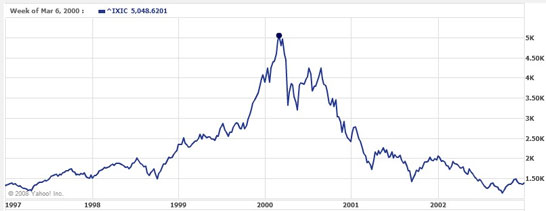
The NASDAQ stock index or “dot.com” bubble in early 2000 hit 5,000.
Ten years later in 2010, this index traded around 2,000, 60% below the bubble’s peak.
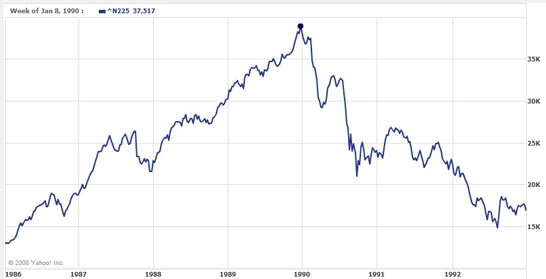
The Tokyo Stock Market Bubble peaked late in 1989 at 37,500.
21 years later in 2010, this index was still only trading at 10,000, 73% below the 1990 peak.
 Another way to know if there is an investing mania is to be aware of what is popular, and what is really just way too popular. Remember, prices are nothing more than a reflection of supply and demand, and if everyone wants something, then its price will skyrocket! But as soon as buyers move on to something else, those prices must plummet! Are the news magazines all writing about an investment? Are they on the covers with splashy headlines and creating a feeding frenzy among the masses? If so, then beware…
Another way to know if there is an investing mania is to be aware of what is popular, and what is really just way too popular. Remember, prices are nothing more than a reflection of supply and demand, and if everyone wants something, then its price will skyrocket! But as soon as buyers move on to something else, those prices must plummet! Are the news magazines all writing about an investment? Are they on the covers with splashy headlines and creating a feeding frenzy among the masses? If so, then beware…
Time magazine’s cover in late 1999 made it seem like everyone was getting rich from Internet stocks

Along these same lines, another warning sign is when your friends are recommending investments without any sound rationale. If you are at a party or any other social gathering and your friends/colleagues start recommending their “hot stocks”, then ask your friends why the stock is “hot.” If they can’t talk about a company’s sales, costs, profits, or strategy for at least 60 seconds, then stay away from that stock!
Time magazine’s cover in Summer 2006, at the height of the U.S. residential real estate bubble
In December 1999, at a holiday party for my work, I sat next to the husband of a colleague. As was typical of the day, the conversation quickly turned to investing in technology stocks. He said that Qualcomm (QCOM) was a great stock to buy NOW, despite the fact that it had already gained over 1,500% that year! He had no personal knowledge of Qualcomm’s business; its proprietary technology, the potential of the wireless phone market or any other fundamental reason to own the stock. All I could think of at this point was the scene in the movie “CaddyShack” when Rodney Dangerfield is playing golf and he gets a call from his stockbroker and he says, “I told you never to call me on the golf course! What’s that? Everyone is buying? Then sell. Sell. Sell!” I quickly sold my shares in QCOM for a sweet profit.
QCOM’s amazing rise in 1999 followed by a money-losing performance in 2000-2002
Unfortunately, manias or “bubbles” are very common in the history of the markets and one must always be vigilant in looking for the next one that might take your hard-earned investment money. While hot stocks and hot asset classes are the most common forms of investing manias and bubbles, investing strategies and trading techniques are also subject to popularity and fads. The following are currently the most popular methods for finding and investing in stocks…

Alright, everyone, take a deep breath and relax. You’ve just been assaulted with a lot of information. Don’t panic. As you view real-world examples of these charts, you’ll become more familiar and comfortable with their interpretations. This and other sites will give you all the additional information you need to continue your current journey and prepare to start another trek toward becoming a charting guru.
Glossary
- Breakout:
- A breakout occurs when a stock’s price moves up quickly above former resistance levels.
- MACD:
- The “moving average convergence/divergence” shows the difference between a fast (like 30 day) and a slow (like 90 day) moving average line of a stock’s prices.
- Moving Average:
- The Moving Average is a line on a chart that smooths out the recent price history by calculating the average price over 30 or 60 days (or any number of days).
- Resistance:
- Resistance in a stock chart forms at an area where the stock’s price seems to not want to move higher. This is due to the presence of sellers at this higher price.
- Support:
- Support in a stock chart forms at an area where the stock’s price seems to not want to move lower. This is due to the presence of buyers at this lower target price.
Further Reading
- How to Read a Stock Trading Chart
- Fundamental vs. Technical Analysis: Pros & Cons, When and How to Use Each
- Cup with Handle Pattern
- Head and Shoulders Top Pattern
- Double Bottom Pattern
- Bearish Continuation Wedge Pattern
- Bullish Continuation Wedge Pattern
- Pennant Patterns
- Candlestick Charting I: Basic Patterns
- Moving Average Convergence Divergence (MACD)
- Fibonacci Ratios in Finance
- 50 Day Moving Averages
- Relative Strength Index (RSI)
- Support & Resistance aka Supply & Demand
- Trade Opportunities using Bollinger Bands
Use the charting tool on you virtual account to generate a graph of one of the stocks in your portfolio and then:
- Change the chart to see how the stock looks on a 1 year graph versus a 1 month chart versus a 1 day chart.
- Change the indicator from line to candlestick
- Change the Chart Type to a logarithmic chart and notice the difference in the Y axis.
- Do you see any type of chart pattern that we mentioned in this chapter? Do you see a cup and handle? Do you see a double bottom pattern?
- Did the stock respond the way you would expect based on the pattern?
- Get a quote on your stock and note the left hand column of the quote page that indicates the current technical pattern. Can you find that pattern?
- Look at the charts of various stocks until you see patterns discussed in this chapter.
- Use the drop down menus to select a new chart style (ie. Candlestick) an upper indicator (ie. SMA or Simple Moving Average) and a lower indicator (ie. MACD).
- Start to become a master of charts and understand what each type of chart has the opportunity to teach you. This is a long process to learn and you should just start to use charts.

 In the 1980s, John Bollinger developed a new technical analysis tool to measure the highs and lows of a security price relative to previous trade data. These “trading bands” help investors track and analyze the “bandwidth” of stock prices over a period.
In the 1980s, John Bollinger developed a new technical analysis tool to measure the highs and lows of a security price relative to previous trade data. These “trading bands” help investors track and analyze the “bandwidth” of stock prices over a period.
The object of Bollinger Bands is to identify a “relative” definition of high and low prices over a specific period. Along with identifying trends, these charts will help you measure the volatility of a security. As you examine the bandwidth of a stock, you will notice the variations (standard deviations) on both the plus and minus sides.
Bollinger Bands are a favorite tool of Swing traders because they produce easy to see tunnels from which to trade as prices reach, or even exceed, the bands.
Veteran analysts and investors often use this information to a) make purchase and sale decisions, and b) to determine where support Support in a stock chart forms at an area where the stock’s price seems to not want to move lower. This is due to the presence of buyers at this lower target price. / resistance Resistance in a stock chart forms at an area where the stock’s price seems to not want to move higher. This is due to the presence of sellers at this higher price. levels are, which may also indicate future movement. You’ll see three lines showing the moving average The Moving Average is a line on a chart that smooths out the recent price history by calculating the average price over 30 or 60 days (or any number of days). (see above) and standard deviations on the high and low side of the stock price.

John Bollinger is known to the public for his many years of market analysis and commentary on television — first on Financial News Network, where he was the Chief Market Analyst — and subsequently on CNBC. John Bollinger is also well known to professional investors. An avid researcher, he has developed a number of widely used investment tools and analytical techniques. His Bollinger Bands and related tools have been integrated into most of the analytical software and charting platforms currently in use.

Support Support in a stock chart forms at an area where the stock’s price seems to not want to move lower. This is due to the presence of buyers at this lower target price. and resistance Resistance in a stock chart forms at an area where the stock’s price seems to not want to move higher. This is due to the presence of sellers at this higher price. are words used in the technical analysis universe. For reasons that are often difficult to quantify, market prices tend to “bounce” off the support and resistance levels that are established.
Support in a stock chart forms at an area where the stock’s price seems to not want to move lower. This is due to the presence of buyers at this lower target price. Support levels sometimes occur by themselves, while other times they are depicted with horizontal trend lines in chart patterns such as a double bottom. When support is broken to the downside, a stock is free to move lower due to the absence of buyers and demand.
Resistance in a stock chart forms at an area where the stock’s price seems to not want to move higher. This is due to the presence of sellers at this higher price.
Resistance levels sometimes occur by themselves, while other times they are depicted with horizontal trend lines in chart patterns such as a triple top pattern. When resistance is broken to the upside, a stock is free to move higher due to the absence of sellers and supply.
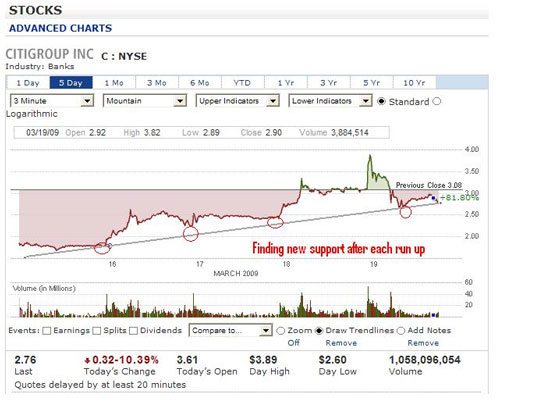 However, during a “ breakout A breakout occurs when a stock’s price moves up quickly above former resistance levels. ” period, prices tend to fly by these former levels until new support or resistance levels occur. As an informed investor, you should attempt to learn the conditions that spurred the stock to increase/decrease beyond its former support and resistance levels to determine if it’s time to buy or sell the security. The support/resistance level is usually shown by a horizontal line across the chart making it easy for you to identify these levels.
However, during a “ breakout A breakout occurs when a stock’s price moves up quickly above former resistance levels. ” period, prices tend to fly by these former levels until new support or resistance levels occur. As an informed investor, you should attempt to learn the conditions that spurred the stock to increase/decrease beyond its former support and resistance levels to determine if it’s time to buy or sell the security. The support/resistance level is usually shown by a horizontal line across the chart making it easy for you to identify these levels.


RSI is the acronym for “Relative Strength Index.” The RSI was created in 1978 by J. Welles Wilder to compare the strength and magnitude of a stock’s gains and losses in recent time periods. The simple formula converts this winning and losing data into a number ranging from 0 to 100.
To keep the analysis simple, you should examine the RSI’s three factors: RS (relative strength), Average Gains, and Average Losses. The formula: 100 – (100/RS + 1), where RS is the Average Gain divided by the Average Loss over the period being studied.
Most analysts use the acronym “RSI” instead of its full name as there are other “relative strength” formula developed by analysts. These “competitors” tend to be more complex and use data from multiple stocks instead of just one as used by the RSI. As a newer investor, the RSI should be more relevant as you try to determine the relative strength or weakness of a security you’re considering putting into or removing from your portfolio.

Moving averages The Moving Average is a line on a chart that smooths out the recent price history by calculating the average price over 30 or 60 days (or any number of days). are among the most popular and – important for the newer investor – easy to use and understand trading “tools” available to you. Also, moving averages are used as components in many other charts and analyses. By smoothing out data points and number series, moving averages make it easier to identify trends and tendencies.
The most common examples are the simple moving average (SMA) and the exponential moving average (EMA). The SMA is generated by calculating the average price (usually closing price is used) over a number of time periods. An EMA attempts to better identify the built in “time lag,” by creating a weighted average, assigning more weight to the most recent prices to allow for the more current data to factor more prominently in future trends.
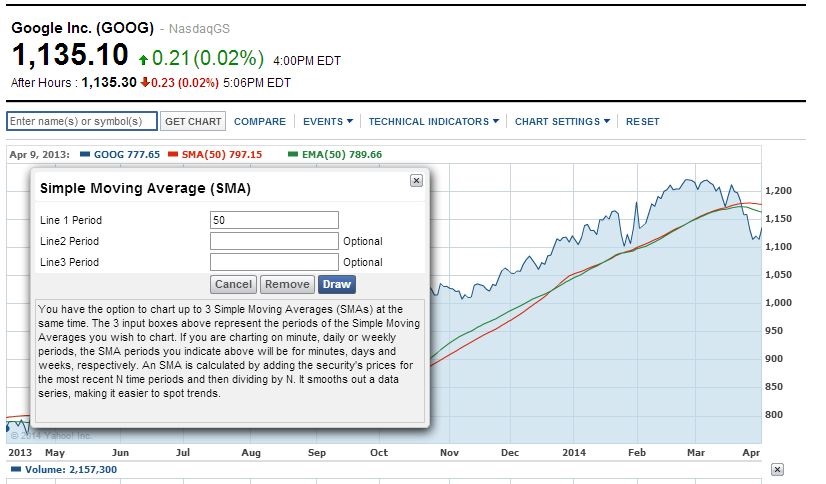

Often called the most accomplished mathematician of the Middle Ages, Leonardo Fibonacci is best known for his “numbers”. It is a sequence starting with 0 and 1, after which every third number is the sum of the previous two numbers. A Fibonacci “sequence” is 0,1,1,2,3,5,8, etc. The Fibonacci “ratios” are 23.6%, 38.2%, 50%, 61.8%, and 100%. These ratios show the mathematical relationship between the number sequences and are important to traders.
For reasons that remain a mystery, Fibonacci ratios often display the points at which a market price reverses its current position or trend. These ratios, when expressed as horizontal lines, often represent supportSupport in a stock chart forms at an area where the stock’s price seems to not want to move lower. This is due to the presence of buyers at this lower target price. and resistance Resistance in a stock chart forms at an area where the stock’s price seems to not want to move higher. This is due to the presence of sellers at this higher price. At these ratio points, stocks often reverse their former trends. You will see this pattern often repeated as you examine these charts.
These ratios form the basis for critical points in the market and allow investors to forecast buying or selling opportunities once they identify the ratio sequence. Traders use Fibonacci ratios to predict the next high or low for a market or stock as seen in this Fibonacci fan chart of Google (GOOG) below.
In the chart above, the Fibonacci retracements for Google are shown from its recent low in early October to the most recent high. Using Fibonacci ratios, traders could see where Google might correct to and as you can see, Google followed the 61.8% retracement level almost exactly! This is not a one-time occurance or freak of nature phenomenon. This happens over and over again. And also notice that this 61.8% retracement level acted as a Support level since that time providing traders “in-the-know” exactly how low Google would fall before going up again!
Fibonacci ratios are one of the most powerful and easiest trading tools in your investor’s toolbox. It provides excellent guidance for when a trend will end and reverse course. However, like any good trading tool, don’t use it alone to make your trading decisions. Use it to support your fundamental observations and other technical indicators.

This is the acronym for “ moving average The Moving Average is a line on a chart that smooths out the recent price history by calculating the average price over 30 or 60 days (or any number of days). convergence/divergence.” Got it? OK, here’s the simple explanation. This graph shows the difference between a fast- or slow-moving average of a stock’s prices. It is designed to identify significant trend changes. This can be a very important tool for you to anticipate trend movements that may occur in the near future. Even as a modest investor, you may be able to generate knowledge that the mega investors spend many dollars and hours to achieve. Analyzing these graphs can give you the same ability to intelligently project what track a security may follow.

Candlesticks are a type of stock chart developed in Japan. Instead of lines, a vertical block, which looks like a candlestick, is used to symbolize a day or week’s worth of price action.
Candlestick charts track price movements of a security over some time period. An interesting combination of a line and a bar chart, candlestick displays are easier to understand than some other varieties of chart. The lines represent individual movement while the bars indicate the “range” of price movement. This gives you a combined picture of immediate term market moves and short-term trends. They are similar to OHLC (open, high, low, close) charts with more detail and trend data.

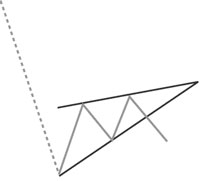 A wedge in the financial universe describes a triangular shape formed by the intersection of two trendlines, which form the apex. The wedge need not be upward facing and can easily be an inverted triangle. The “falling wedge” is often called a “flag” since it more resembles a pointed flag more than a typical triangle.
A wedge in the financial universe describes a triangular shape formed by the intersection of two trendlines, which form the apex. The wedge need not be upward facing and can easily be an inverted triangle. The “falling wedge” is often called a “flag” since it more resembles a pointed flag more than a typical triangle.
A Bearish Wedge, or Flag, consists of two converging trend lines. The trend lines are slanted upward. Unlike the Triangles where the apex is pointed to the right, the apex of this pattern is slanted upwards at an angle. This is because prices edge steadily higher in a converging pattern i.e. there are higher highs and higher lows. A bearish signal occurs when prices break below the lower trendline.
A Bullish Wedge or Flag consists of two converging trend lines. The trend lines are slanted downward. Unlike the Triangles where the apex is pointed to the right, the apex of this pattern is slanted downwards at an angle. This is because prices edge steadily lower in a converging pattern i.e. there are lower highs and lower lows. A bullish signal occurs when prices break above the upper trendline.
 Since the data creating the design is typically slanted against the current trend, a descending flag is considered a “bullish” indicator, while a wedge is viewed as a “bearish” predictor. A typical wedge or flag lasts longer than one month but less than three months. Longer trends will often create designs other than a wedge or a flag.
Since the data creating the design is typically slanted against the current trend, a descending flag is considered a “bullish” indicator, while a wedge is viewed as a “bearish” predictor. A typical wedge or flag lasts longer than one month but less than three months. Longer trends will often create designs other than a wedge or a flag.
Take a look at this chart that contained a Bullish Flag formation that preceded a strong rally:

Pennants are popular with Day Traders because this chart pattern rarely shows up in longer time frames. If you like to trade shorter term, you should be looking at charts closely for pennants and you may start seeing them in your dreams at night because they are so reliable and common.

You’re probably aware that trendlines are important to all of your research on potential purchases or sales of securities. Base numbers are equally important to understand the true meaning of any trends you identify. Depending on the type of chart you are viewing, you’ll also want to establish a solid, unbroken trendline of your own that graphically displays the unmistakable direction in which a stock (or stocks) is heading.
Notice the trend line in the chart above for the overall stock market was sloping upward, indicating a Bullish, or rising market.
Also, be sure to watch for changes in a trendline. They might be subtle. However, if you plot the trendline carefully, you’ll see that your line may take a slightly different direction. In the above chart, see how the long-term upward sloping trend-line was broken in 2008? That tells you when the trend is changing, or has already changed.
On most virtual accounts you can use the charts to draw your own trendlines by clicking the “Draw Trendlines” box at the bottom and then clicking on the chart to draw trend lines.
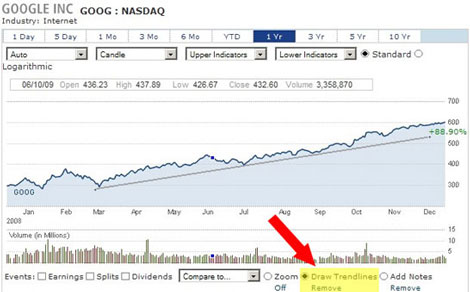

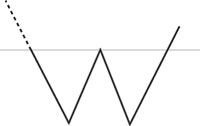 A double bottom chart will look like a “W.” It indicates that the stock hit bottom market price, had a quick – albeit brief – uptick, and decreased again to turn a “V” shape into a “W.” The two reverse peaks should be around the same floor price and the time period should be similar to create the fairly well-formed “W.”
A double bottom chart will look like a “W.” It indicates that the stock hit bottom market price, had a quick – albeit brief – uptick, and decreased again to turn a “V” shape into a “W.” The two reverse peaks should be around the same floor price and the time period should be similar to create the fairly well-formed “W.”
A Double Bottom is only complete, however, when prices rise above the high end of the point that formed the second low.
The two lows will be distinct. The pattern is complete when prices rise above the highest high in the formation. The highest high is called the “confirmation point”.
Analysts vary in their specific definitions of a Double Bottom. According to some, after the first bottom is formed, a rally of at least 10% should follow. That increase is measured from high to low. This should be followed by a second bottom. The second bottom returning back to the previous low (plus or minus 3%) should be on lower volume than the first. Other analysts maintain that the rise registered between the two bottoms should be at least 20% and the lows should be spaced at least a month apart.
Look at the chart below that shows a very well defined double bottom and then the ensuing rise:
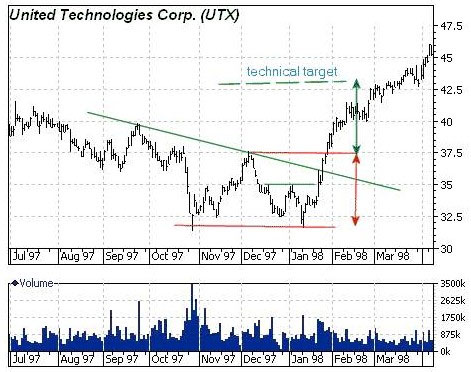

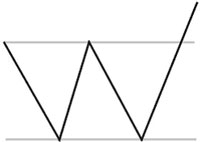 A breakoutA breakout occurs when a stock’s price moves up quickly above former resistance levels. occurs when market prices move through and continue through former highs/lows that had formed ceilings or floors in the past. Commonly called levels of “ support Support in a stock chart forms at an area where the stock’s price seems to not want to move lower. This is due to the presence of buyers at this lower target price. ” and “ resistance Resistance in a stock chart forms at an area where the stock’s price seems to not want to move higher. This is due to the presence of sellers at this higher price.,” these former limits are breached during a breakout. This chart is rather easy to understand as you see historic peaks and valleys that are fairly consistent, when suddenly the most recent trendline quickly moves up or down toward new highs/lows.
A breakoutA breakout occurs when a stock’s price moves up quickly above former resistance levels. occurs when market prices move through and continue through former highs/lows that had formed ceilings or floors in the past. Commonly called levels of “ support Support in a stock chart forms at an area where the stock’s price seems to not want to move lower. This is due to the presence of buyers at this lower target price. ” and “ resistance Resistance in a stock chart forms at an area where the stock’s price seems to not want to move higher. This is due to the presence of sellers at this higher price.,” these former limits are breached during a breakout. This chart is rather easy to understand as you see historic peaks and valleys that are fairly consistent, when suddenly the most recent trendline quickly moves up or down toward new highs/lows.
The duration of the trading range for which the breakout occurred can provide an indication of the strength of the breakout to follow. The longer the duration of the trading range, the more significant the breakout will be.
A classic breakout occurred for Gold (GLD) in autumn 2009. After twice getting halted at about $1,000/oz ($100 for the ETF GLD), gold blasted through this resistance level as can be seen in this 3-year chart:


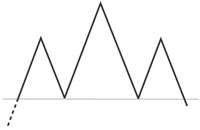 Don’t you love the terminology that pictorially associates these charts with their graphic representations? The Head and Shoulders is an extremely popular pattern among investors because it’s one of the most reliable of all chart formations. It also appears to be an easy one to spot. Novice investors often make the mistake of seeing Head and Shoulders everywhere. Seasoned technical analysts will tell you that it is tough to spot the real occurrences.
Don’t you love the terminology that pictorially associates these charts with their graphic representations? The Head and Shoulders is an extremely popular pattern among investors because it’s one of the most reliable of all chart formations. It also appears to be an easy one to spot. Novice investors often make the mistake of seeing Head and Shoulders everywhere. Seasoned technical analysts will tell you that it is tough to spot the real occurrences.
A Head and Shoulders is considered a bearish signal and that prices will fall after the formation is complete. A head and shoulders top chart has a left “shoulder,” a “head,” and a right “shoulder,” usually with a horizontal bar indicating a “neckline.” A mirror image of the top variety, a bottom head and shoulders chart looks like someone hanging upside down.
On the top side, left shoulders result at the peak of a sustained move with high volume numbers. The market reacts and prices decline, usually on lesser volume. Quickly, market value rallies upward to form the “head” on rather heavy volume. Then, fewer shares are traded, but mostly on the sell side, causing prices to drop. Subsequently, another rally occurs, which forms the right “shoulder” (not has high as the head). Finally, another sell off occurs, typically on lower volume numbers, again, and the “shoulder” is complete.
On the bottom side, the mirror image of buying/selling and increasing/decreasing market prices occurs. Analyzing this chart involves learning of the reasons, valid or not, for this volatile activity.
Take a look at this example of head and shoulders pattern in Gold that suggested a breakout A breakout occurs when a stock’s price moves up quickly above former resistance levels. higher was imminent:

The Cup with a Handle pattern is one of the best-known stock chart patterns. The Cup patterns follow outlines that simulate an inverted semi-circle (U-shape), indicating a price fall, a bottoming out, and a price rise. Afterwards, there tends to be a rather unstable period marked by a sell-off generated by investors who acquired the stock near its former position. This often causes a slight tick downward, forming the handle of the cup.

A saucer pattern forms when a security has bottomed out for a while and then starts to move upward. The flattened U-shape resembles a saucer:
The cup always precedes the handle. As the cup develops, the price pattern follows a gradual bowl shape. There should be an obvious bottom to the bowl; a v-shaped turn is not a good indicator.
The depth of the cup indicates the potential for a handle and subsequent breakout A breakout occurs when a stock’s price moves up quickly above former resistance levels. to develop. The cup should be fairly shallow.
The handle tends to be down sloping, and indicates a period of consolidation. Consolidation occurs when the price seems to bounce between an upper and lower price limit. You can track the down sloping angle of the handle by drawing trendlines across the upper and lower price limits. If the price ascends outside of the trendlines, then it has the potential for breakout. If the price ascends beyond the upper, right side of the cup, then the pattern is confirmed, particularly if it is accompanied with a sharp increase in volume.
When to Buy
Understandably, we investors like to buy at the lowest possible price. Ideally, we would buy at the bottom of the cup formation. However, by the time the handle formation begins to develop, investors must gauge their level of risk. There is no surefire way to predict when the lowest point will occur, and there is a possibility that the pattern will fail, and breakout in a downtrend.
Some technical analysts believe that the best time to buy is after the handle begins to ascend. According to Rick Martinelli and Barry Hyman, “buy stocks only as they break out of the cup-with-handle to new highs”. Khun suggests a more aggressive method of buying stocks. He suggests that “experienced traders can buy in increments in anticipation of a breakout, but it’s tricky.”
The handle will often slope downwards initially, however, watch for the price to breakout beyond the price at the right side of the cup. The depth of the cup from the right side is an indicator for the potential price increase. However, many cups fail after rising only 10% to 15%. Be sure to use stop-loss orders to limit losses or to maximize gains.





